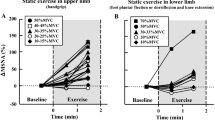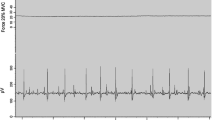Abstract
The aim of this study was to examine the effects of muscle fibre composition on muscle sympathetic nerve activity (MSNA) in response to isometric exercise. The MSNA, recorded from the tibial nerve by a microneurographic technique during contraction and following arterial occlusion, was compared in three different muscle groups: the forearm (handgrip), anterior tibialis (foot dorsal contraction), and soleus muscles (foot plantar contraction) contracted separately at intensities of 20%, 33% and 50% of the maximal voluntary force. The increases in MSNA relative to control levels during contraction and occlusion were significant at all contracting forces for handgrip and at 33% and 50% of maximal for dorsal contraction, but there were no significant changes, except during exercise at 50%, for plantar contraction. The size of the MSNA response correlated with the contraction force in all muscle groups. Pooling data for all contraction forces, there were different MSNA responses among muscle groups in contraction forces (P = 0.0001, two-way analysis of variance), and occlusion periods (P = 0.0001). The MSNA increases were in the following order of magnitude: handgrip, dorsal, and plantar contractions. The order of the fibre type composition in these three muscles is from equal numbers of types I and II fibres in the forearm to increasing number of type I fibres in the leg muscles. The different MSNA responses to the contraction of different muscle groups observed may have been due in part to muscle metaboreflex intensity influenced by their metabolic capacity which is related to by their metabolic capacity which is related to the fibre type.
Similar content being viewed by others
References
Folkow B, Halicka HD (1968) A comparison between “red” and “white” muscle with respect to blood supply, capillary surface are and oxygen uptake during rest and exercise. Microvasc Res 1:1–14
Frisk-Holmberg M, Essén B, Fredrikson M, Ström G, Wibell L (1983) Muscle fibre composition in relation to blood pressure to isometric exercise in normotensive and hypertensive subjects. Acta Med Scand 213:21–26
Hof AL, Berg JW, van Den (1977) Linearity between the weighted sum of the EMGs of the human tricheps surae and the total torque. J Biomech 10:529–539
Holloszy JO, Booth FW (1976) Biochemical adaptations to endurance exercise in muscle. Annu Rev Physiol 38:273–291
Johnson MA, Polgar J, Weightman D, Appleton D (1973) Data on the distribution of fibre types in thirty-six human muscles: an autopsy study. J Neurol Sci 18:111–129
Kilbom Å, Persson J (1981) Circulatory response to static muscle contractions in three different muscle group. Clin Physiol 1:215–225
Mark AL, Victor RG, Nerhed C, Wallin BG (1985) Micro-neurographic studies of the mechanisms of sympathetic nerve responses to static exercise in humans. Circ Res 57:461–169
Mitchell JH, Payne, FC, Saltine B, Schibye B (1980) The role of muscle mass in the cardiovascular response to static contractions. J Physiol 309:45–54
O'Leary DS (1993) Autonomic mechanisms of muscle metaboreflex control of heart rate. J Appl Physiol 74:1748–1754
Petrofsky JS, Phillips CA, Sawka MN, Hanpeter D, Lind AR, Stafford D (1981) Muscle fiber recruitment and blood pressure response to isometric exercise. J Appl Physiol 50:32–37
Sadamoto T, Mutoh Y, Miyashita M (1992) Cardiovascular reflexes during sustained handgrip exercise: role of muscle fiber composition, potassium and lactate. Eur J Appl Physiol 65:324–330
Saito M, Mano T, Abe H, Iwase S (1986) Responses in muscle sympathetic nerve activity to sustained hand-grips of different tensions in humans. Eur J Appl Physiol 55:495–498
Saito M, Mano T, Iwase S (1989) Sympathetic nerve activity related to local fatigue sensation during static contraction. J Appl Physiol 67:980–984
Saito M, Mano T, Iwas S (1990a) Changes in muscle sympathetic nerve activity and calf blood flow during static handgrip exercise. Eur J Appl Physiol 60:277–281
Saito M, Naito M, Mano T (1990b) Different responses in skin and muscle sympathetic nerve activity to static muscle contraction. J Appl Physiol 69:2085–2090
Seals DR (1989a) Influence of muscle mass on sympathetic neural activation during isometric exercise. J Appl Physiol 67:1801–1806
Seals DR (1989b) Sympathetic neural discharges and vascular resistance during exercise in humans. J Appl Physiol 66:2472–478
Seals DR, Chase PB, Taylor JA (1988) Autonomic mediation of the pressor responses to isometric exercise in humans. J Appl Physiol 64:2190–2196
Vallbo ÅB, Hagbarth K-E, Torebjörk HE, Wallin BG (1979) Somatosensory, proprioceptive, and sympathetic activity in human peripheral nerve. Physiol Rev 59:919–957
Victor RG, Bertocci LA, Pryor SL, Nunnally RL (1988) Sympathetic nerve discharge is coupled to muscle cell pH during exercise in humans. J Clin Invest 82:1301–1305
Author information
Authors and Affiliations
Rights and permissions
About this article
Cite this article
Saito, M. Differences in muscle sympathetic nerve response to isometric exercise in different muscle groups. Europ. J. Appl. Physiol. 70, 26–35 (1995). https://doi.org/10.1007/BF00601805
Accepted:
Issue Date:
DOI: https://doi.org/10.1007/BF00601805




